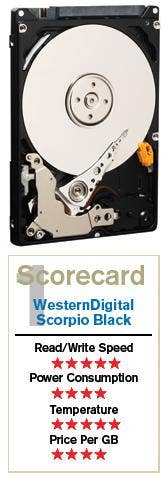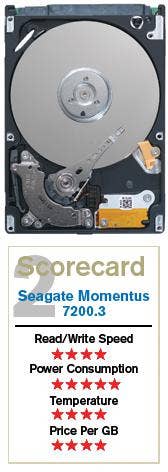Bake-off: Notebook Hard Drives
The CRN Test Center invited various hard drive manufacturers to each submit a 2.5-inch hard drive for this comparative review. They were told that the drives would be evaluated on their read and write times, heat generation, power draw and price per GB. Altogether, three companies submitted drives and we've included a fourth that, prior to our requests, was recently sent to the lab for review.
Our test bed for this bakeoff was an Antec Inc. Skeleton chassis housing an AsusTek Computer Inc. P5Q3 Deluxe motherboard with an Intel Corp. Core 2 Duo E8500 processor and 2 GB of Kingston Technology Corp. DDR3 HyperX memory. A 160-GB Western Digital Corp. Caviar 3.5-inch drive was used for the operating system, which was Microsoft Corp.'s Windows Vista Ultimate, and each notebook drive was connected as a secondary drive, one at a time.

Read and write speeds were assessed by timing the transfer of two folders, one containing 1.2 GB of files and the other 3.2 GB, between the test drive and the system's. Although we were able to see a slight difference in power usage on the drives, we also used the company-specified consumption for a more precise comparison.
Each of the drives from participating companies Fujitsu Computer Products of America Inc., Seagate Technology Inc., Western Digital and Samsung Electronics America Inc. had similar specs, although capacities varied and one had a 5,400 rpm rotational speed (the others were all 7,200 rpm). Additionally, we decided to use current street prices for the ratings because of the wide disparity between those and the MSRPs. Noise levels for all the drives are specified at 25 dB, with the exception of the Samsung, which is 27 dB.
Just barely breaking a virtual tie for the lead, Western Digital's Scorpio Black (WD3200BEKT) is a 320-GB drive spinning at 7,200 rpm, with a 16-MB buffer. Read times clocked in at 31 seconds for the 1.2-GB folder and 2 minutes 20 seconds for the 3.2-GB folder. Write times were 30 seconds and 2 minutes 1 second, respectively.
Specified at 2.5 watts average power consumption during seek, the WD drive has the highest rated draw of the four, but during our testing, it actually came in the lowest. Its temperature readings were also the lowest at 90.7 degrees Fahrenheit on the front of the case and 93.6 F on the back. The Scorpio Black had the highest MSRP ($199) but, similar to the wattage measurements, the street price was much less, at about $105. This gives it a slightly elevated per-GB price of 33 cents.
The WD drive is available in five different capacities, ranging from 80 GB up to 320 GB, and is also offered with a free-fall sensor that detects when the drive (or the device it's in) is falling and, in less than 200 milliseconds, parks the head to help prevent damage and data loss.

Coming in a very close second in this comparative review was the Seagate Momentus 7200.3 (ST9320421AS). Similar to the Scorpio, it is also a 320-GB drive, with a 7,200 rpm spindle speed and a 16-MB cache. The 7200.3 read the 1.2-GB folder in 30 seconds flat and the 3.2-GB folder in 2 minutes, 25 seconds. Alternately, it wrote the 1.2-GB folder in 32 seconds and the 3.2-GB folder in 2 minutes, 1 second. Power use is rated at 2.1 watts, the lowest of the four drives, and our tests had it lingering at almost the same draw as the WD.
The 7200.3 also came very close to the Scorpio in temperature readings. We measured the front of the case at 91.5 F, while the back was 93.9 F. With a street price hovering in the $100 range, the Seagate averaged 31 cents per GB. It, too, is available in the same five capacities as the WD, also including a model with a drop sensor (what the company calls "G-Force Protection") that reacts within three-tenths of a second.
The Samsung Spinpoint M6 that we tested (HM500LI) is a 500-GB drive—the highest capacity 2.5-inch drive available at this time—which is also available in a 400-GB model. At the time of its release in March, the HM500LI was the world's first notebook drive of this size. Additional versions include 250 GB and 320 GB, although those use a 1.5-Gbps SATA interface instead of 3.0-Gbps SATA like the others. All versions have an 8-MB buffer and a rotational speed of 5,400 rpm.
Compared to the other drives in this review, the HM500LI had slightly faster write times at 30 seconds for the 1.2-GB folder and 2 minutes, 15 seconds for the 3.2 GB. Likewise, read times were 31 seconds and 2 minutes, 16 seconds. The rated power draw of 2.4 watts puts it on the higher end of the group, which our tests confirmed. Temperature ratings were also elevated, with the front of the case measuring 93.2 F and the back 94.2 F.

Most likely because of the increased capacity, the HM500LI had the lowest average per-GB street price, at approximately 30 cents. As the previous contenders, a free-fall sensor is available as an optional feature.
The final unit we evaluated was the Fujitsu MHZ2250CJ. Although we are including it in this review, we decided not to rank it with the other drives because it has the added feature of AES 256-bit hardware-based encryption. This put it at an unfair disadvantage for many of the ratings, including price.
The MHZ2250CJ is a 250-GB model with a 7,200 rpm rotational speed and 16-MB buffer. When used in computers where the BIOS supports it, the drive implements the AES hardware encryption directly into the processor chip of the hard drive. This allows for more robust security and faster system performance than software-based encryption. Other available capacities include 80 GB, 120 GB, 160 GB and 320 GB.
Reviewers timed the MHZ2250CJ's write speeds at 31 seconds for the 1.2-GB folder and 2 minutes, 29 seconds for the 3.2-GB folder, and read speeds at 32 seconds, 2 minutes, 26 seconds, respectively. Power consumption is rated typically at 2.3 watts during reading and writing.
Among all the drives tested, the Fujitsu had the highest temperature readings at 95.6 F at the front of the case and 97.7 F at the back. With an MSRP (and similar street price) of $199, the MHZ2250CJ averages 80 cents per GB.
When it comes right down to it, you would be safe using any of these drives for a notebook upgrade. For those trying to eke out every last millisecond of battery life, the models with the lowest power consumption might be a bit more attractive.
Others may be looking to gain those same milliseconds on the performance side. These three drives are similar enough in price and specs, so they shouldn't disappoint. And where data security is a priority, Fujitsu has you covered too.